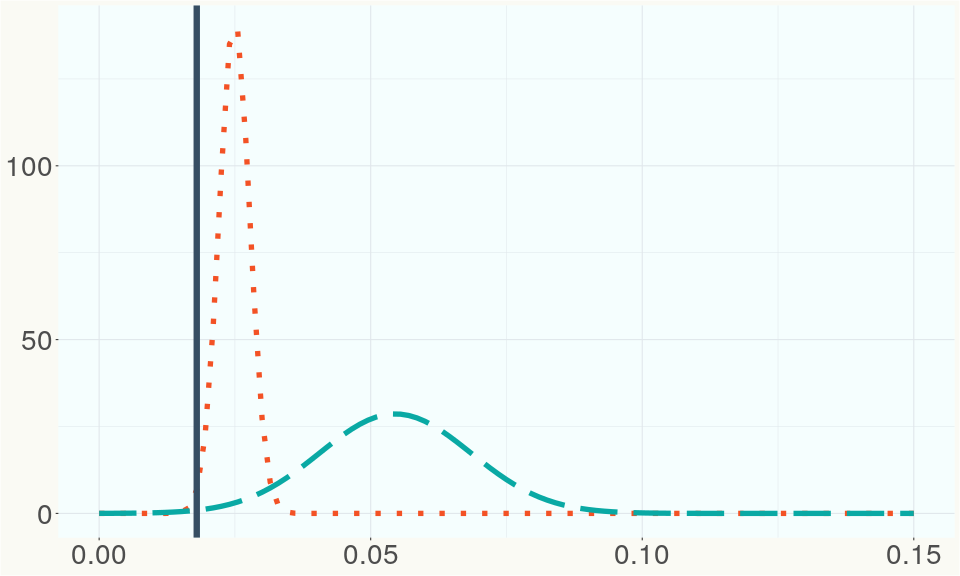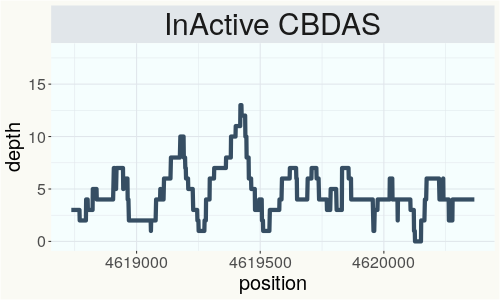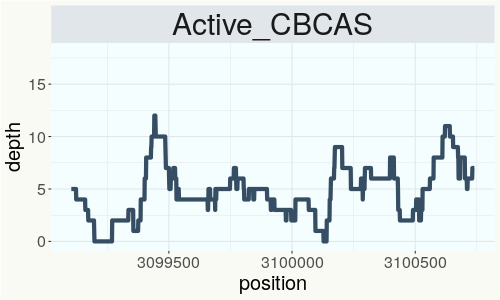JL x MC7
RSP 13213
Grower: kevin Mckernan
General Information
- Sample Name
- JL x MC7-Flower
- Accession Date
- September 11, 2024
- Reported Plant Sex
- Female
- Report Type
- Whole-Genome Sequencing
- Microbiome
- Krona Plot
- Fungal Microbiome
- Krona Plot
- Bacterial Microbiome
- Krona Plot
- Viral Microbiome
- Krona Plot
- PathoSEEK® ID Report
- RSP13213-PathoSEEKID.html
The strain rarity visualization shows how distant the strain is from the other cultivars in the Kannapedia database. The y-axis represents genetic distance, getting farther as you go up. The width of the visualization at any position along the y-axis shows how many strains there are in the database at that genetic distance. So, a common strain will have a more bottom-heavy shape, while uncommon and rare cultivars will have a visualization that is generally shifted towards the top.
Chemical Information
Cannabinoid and terpenoid information provided by the grower.
Cannabinoids
No information provided.
Terpenoids
No information provided.
Genetic Information
- Plant Type
- Type II
File Downloads
The bell curve in the heterozygosity visualization shows the distribution of heterozygosity levels for cannabis cultivars in the Kannapedia database. The green line shows where this particular strain fits within the distribution. Heterozygosity is associated with heterosis (aka hybrid vigor) but also leads to the production of more variable offspring. When plants have two genetically different parents, heterozygosity levels will be higher than if it has been inbred or backcrossed repeatedly.
The ratio of reads mapped to Y-contigs to reads mapped to the whole Cannabis genome (Y-ratios) has been demonstrated to be strongly correlated with plant sex typing. This plot shows the distribution of Y-ratios for all samples in our database which were sequenced with the same method (panel or WGS) as this sample and where this sample falls in the distribution.

This chart represents the Illumina sequence coverage over the Bt/Bd allele. These are the three regions in the cannabis genome that impact THCA, CBDA, CBGA production. Coverage over the Active CBDAS gene is highly correlated with Type II and Type III plants as described by Etienne de Meijer. Coverage over the THCA gene is highly correlated with Type I and Type II plants but is anti-correlated with Type III plants. Type I plants require coverage over the inactive CBDA loci and no coverage over the Active CBDA gene. Lack of coverage over the Active CBDA and Active THCA allele are presumed to be Type IV plants (CBGA dominant). While deletions of entire THCAS and CBDAS genes are the most common Bt:Bd alleles observed, it is possible to have plants with these genes where functional expression of the enzyme is disrupted by deactivating point mutations (Kojoma et al. 2006).



This chart represents the Illumina sequence coverage over the CBCA synthase gene.

Variants (THCAS, CBDAS, and CBCAS)
No variants to report
Variants (Select Genes of Interest)
| PHL-2 | c.1057A>G | p.Arg353Gly | missense variant | moderate | contig2621 | 340335 | A/G | |
| PHL-2 | c.2756A>C | p.Glu919Ala | missense variant | moderate | contig2621 | 342799 | A/C | |
| DXR-2 | c.1319T>C | p.Ile440Thr | missense variant | moderate | contig380 | 285250 | A/G |
|
| ELF3 | c.358G>A | p.Gly120Arg | missense variant | moderate | contig97 | 242064 | G/A | |
| ELF3 | c.1466G>A | p.Ser489Asn | missense variant | moderate | contig97 | 244297 | G/A |
|
| ELF3 |
c.1803_1805d |
p.His601del | disruptive inframe deletion | moderate | contig97 | 244625 | ACAT/A |
|
| ELF5 | c.853C>T | p.Pro285Ser | missense variant | moderate | contig382 | 880715 | C/T | |
| HDS-2 | c.127T>G | p.Ser43Ala | missense variant | moderate | contig95 | 1989794 | T/G |
|
| AAE1-2 | c.331A>G | p.Asn111Asp | missense variant | moderate | contig81 | 209293 | A/G |
|
| PHL-1 | c.2651C>T | p.Ala884Val | missense variant | moderate | contig1439 | 1487146 | G/A | |
| PHL-1 | c.2623A>G | p.Thr875Ala | missense variant | moderate | contig1439 | 1487174 | T/C |
|
| PHL-1 | c.2561A>T | p.Asn854Ile | missense variant | moderate | contig1439 | 1487236 | T/A | |
| PHL-1 | c.2551A>G | p.Thr851Ala | missense variant | moderate | contig1439 | 1487246 | T/C | |
| HDS-1 | c.136G>A | p.Val46Ile | missense variant | moderate | contig1891 | 889256 | C/T | |
| HDS-1 |
c.-108+1_-10 |
splice donor variant & intron variant | high | contig1891 | 889975 | A/AC |
|
|
| AAE1-3 | c.722G>A | p.Arg241Lys | missense variant | moderate | contig976 | 1083132 | C/T |
|
| GGR | c.704A>T | p.His235Leu | missense variant | moderate | contig2282 | 549696 | A/T |
|
| PKSB-3 | c.1652A>G | p.Glu551Gly | missense variant | moderate | contig93 | 3339759 | A/G |
|
Nearest genetic relatives (All Samples)
- 0.151 JL x MandarinCookies XX THC 5 (RSP13167)
- 0.156 JL x MC5 (RSP13212)
- 0.162 JL x MandarinCookies XX THC 10 (RSP13168)
- 0.163 JL yellow (RSP11075)
- 0.168 Jamaican Lion (RSP12917)
- 0.171 JL 3rd Gen Mother (RSP11214)
- 0.174 Jamaican Lion (RSP12915)
- 0.174 JL 3rd Gen Mother (RSP11197)
- 0.178 JL 4th Gen 2 (RSP11194)
- 0.182 JL 4th Gen 4 (RSP11198)
- 0.186 JL 4th Gen 1 (RSP11193)
- 0.188 JL 4th Gen 5 (RSP11199)
- 0.188 Jamaican Lion (RSP12916)
- 0.191 JL 4th Gen 3 (RSP11195)
- 0.199 Jamaican Lions Ancestor (RSP11127)
- 0.225 JL 4th Gen 7 (RSP11153)
- 0.238 Jamaican Lion (RSP12913)
- 0.238 Jamaican Lion (RSP12920)
- 0.239 Jamaican Lion (RSP12918)
- 0.241 Jamaican Lion (RSP12919)
Most genetically distant strains (All Samples)
- 0.552 BCH Rt-Fl (RSP13141)
- 0.488 PK Dried (RSP13123)
- 0.475 Fatso (RSP11741)
- 0.472 Chem 91 (RSP11185)
- 0.471 CS (RSP11208)
- 0.471 Feral (RSP11205)
- 0.470 Red Eye OG (RSP11190)
- 0.469 Cherry Blossom (RSP11317)
- 0.468 GMO x Poison Momosa (RSP12626)
- 0.467 T20 Dried (RSP13125)
- 0.466 Purple Urkle (RSP12890)
- 0.464 Rainbow Belts 3 0 11 (RSP12801)
- 0.463 Badger G (RSP13082)
- 0.463 Rainbow Belts 1 0 (RSP12911)
- 0.462 Cherry Blossom (RSP11324)
- 0.461 Cherry Blossom (RSP11333)
- 0.460 80E (RSP11213)
- 0.457 PK Drying (RSP13124)
- 0.456 JL Cross 6 (RSP11507)
- 0.452 PK (RSP13087)
Nearest genetic relative in Phylos dataset
- Overlapping SNPs:
- 95
- Concordance:
- 56
Nearest genetic relative in Lynch dataset
- Overlapping SNPs:
- 10
- Concordance:
- 8
Blockchain Registration Information
- Transaction ID
-
RSP13213-mgc-ots
-certificate - Stamping Certificate
- Download PDF (1.2 MB)
- SHASUM Hash
-
5e6be3f6c056852dab6b95df51f1b5fb b66a89fcdac3c26a dc7528982ac4e762